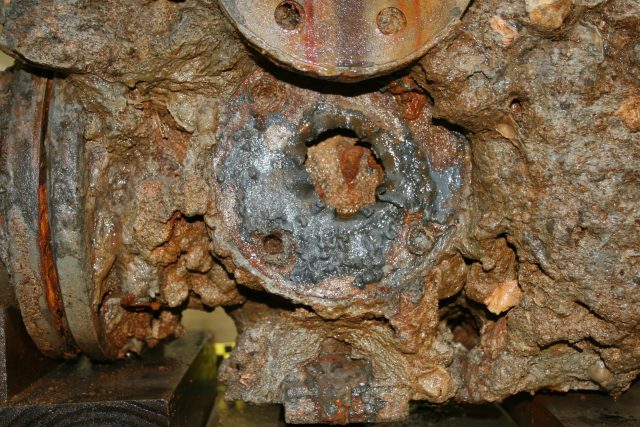This week I thought it might be fun to look at one of our more unusual types of artifacts that I’ve been treating. We have tons (literally) of iron and copper artifacts in the lab, but for every two pipe flanges bolted together, there is also one gasket keeping things tight. The humble gasket can be found throughout the Monitor’s engine room, sandwiched between the copper piping and iron machinery parts. Its job was to keep the fittings air tight and prevent leaks. Most gaskets are made from layers of rubber and textile pressed together, but we do have gaskets made entirely of rubber and a few that are actually leather.

In addition to the gaskets, rubberized fabric, buttons, and combs have also been recovered. Despite the evidence of wide use aboard the Monitor, modern rubber was a relatively new material in 1862. Natural rubber was used before the 1800’s, but due to its unstable nature, it wasn’t suitable for many applications. Thanks to a number of people experimenting with additives and curing processes, more stable forms of rubber became commercially available. For instance, Charles Goodyear (who’s patent is stamped on the Monitor buttons) is credited with patenting vulcanized rubber which is much harder and durable than natural rubber.
Most of the information we have about rubber in museums comes from non-archaeological collections. However most of the rubber found in cars, scientific equipment, and modern art has not altered much from when it was first made. Archaeological rubber can change radically depending on its burial environment. In the last forty years, archaeologists have been able to access shipwrecks and also focus more on modern terrestrial sites. This means an increase in the number of rubber artifacts requiring treatment. Therefore, the work done on the Monitor‘s gaskets is very important. It not only provides conservators with an example of how to conserve marine archaeological rubber, but even better, we now have a collection of archaeological gaskets in storage that we can examine as they age.
So how do we conserve the gaskets?
Our treatment policy for the engine room assemblage is to break the machinery down into as many component parts as possible. This allows us to separate dissimilar materials and treat them individually. It also grants us greater access into internal spaces which enables us to clean out more of the concretion and sediment which worked its way into the machinery after the ship sank. During this process we have removed over 50 gaskets. The engine’s running total is 8 and the condenser’s is a respectable 14. These numbers will increase as the disassembly continues.



Once the gaskets are removed from their flange faces, we store them in our walk-in cooler. This is where all our organic material is kept because the low temperatures help preserve the material and keep bio growth to a minimum. The treatment for rubber gaskets isn’t as intense as some of the other materials we treat. Usually cleaning and iron stain removal are all that is required. The difficulty in conserving gaskets lies in the drying process and storage. Gaskets need to be dried out slowly to avoid physical issues like the rubber shrinking, the layers separating, or the edges curling.
Rubber degrades in the presence of light and oxygen, which make them one of the more finicky materials from the shipwreck. To mitigate damage, the gaskets are stored in oxygen free bags in cardboard boxes.


